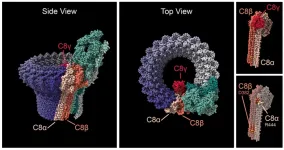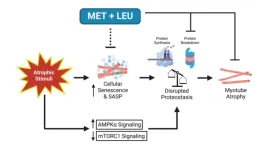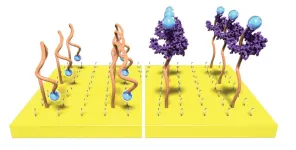(Press-News.org) A study from the National Eye Institute (NEI) identified rare genetic variants that could point to one of the general mechanisms driving age-related macular degeneration (AMD), a common cause of vision loss in older adults. The variants generate malformed proteins that alter the stability of the membrane attack complex (MAC), which may drive a chronic inflammatory response in the retina. The findings, published in the journal iScience, point to MAC as a potential therapeutic target to slow or prevent the development of AMD. NEI is part of the National Institutes of Health.
There are many known genetic variants that raise or lower an individual’s risk of getting AMD; however, the contribution of each of these genetic changes to AMD is small.
To discover genetic variants – and proteins – with a direct tie to the disease, Anand Swaroop, Ph.D., chief of NEI’s Neurobiology, Neurodegeneration and Repair Laboratory, and lead author of the study, undertook a collaboration with Michael Klein, M.D., a leading AMD clinician at the Oregon Health Sciences University (OHSU), Portland. Klein has collected clinical information for hundreds of patients, as well as families with a high number of individuals with AMD. Swaroop, Klein and colleagues looked for families carrying very rare AMD-causing variants, where the effect of the gene variant is very strong, and where the variant directly affects protein structure and function. This type of rare variant can reveal the root cause of disease.
“While we have known about many genetic variants that affect AMD risk, only a few have pointed directly to protein alterations that can cause AMD,” said Swaroop. “By looking at large families with ultra-rare variants that track closely with disease across generations, we found two proteins that may directly be the driving force behind AMD pathology in affected patients. These proteins could be targets for future drugs.” While there are currently some treatments to slow vision loss for people with the wet form of AMD, there is no treatment for most patients and no cure for the disease.
Swaroop, Klein and colleagues found that in four families, individuals with AMD have mutations in one of two proteins that form one end of MAC: C8-alpha and C8-beta. The team found that the variants from the four AMD families all affected the ability of the C8 proteins to stick to each other, which may alter how MAC behaves in the eye’s retina.
MAC forms a circular pore, closed at one end by the C8 proteins; the MAC pore permits the flow of ions through the outer membrane of cells. This pore is the final step in the ‘complement cascade,’ a part of the immune system that helps the body defend against pathogens. Although scientists initially thought that MAC’s only function was to insert into bacterial cell membranes and kill the pathogen, more recent evidence shows that MAC plays a complex role in regulating inflammatory processes in tissues like the retina.
Genetic data from NEI’s Age Related Eye Disease Studies have suggested roles for C8 proteins, as well as other proteins higher up in the complement cascade, in AMD. Because MAC is the final step in the complement cascade, variants affecting any of the complement proteins may funnel down to alter MAC function. The researchers believe that either too much or too little stable MAC in the retina may lead to destructive inflammation, which in turn drives AMD progression.
“Given that MAC is the end of the immune system’s complement pathway, and because there’s such a strong link between these rare variants and disease, we think that targeting it may be a more effective strategy to control AMD,” Swaroop said. “With a small molecule drug, we might be able to control how strongly MAC drives inflammation, and from there slow down progression of AMD.”
The research was funded by the National Eye Institute, as well as Research to Prevent Blindness, the Retina Research Foundation, and the Casey Eye Institute Macular Degeneration Center.
Reference: Zelinger L, Martin TM, Advani J, Campello L, English MA, Kwong A, Weber C, Maykoski J, Sergeev YV, Fariss R, Chew EY, Klein ML, and Swaroop A. “Ultra-rare complement factor 8 coding variants in families with age-related macular degeneration.” iScience. April 1, 2023.
###
NEI leads the federal government’s research on the visual system and eye diseases. NEI supports basic and clinical science programs to develop sight-saving treatments and address special needs of people with vision loss. For more information, visit https://www.nei.nih.gov.
About the National Institutes of Health (NIH): NIH, the nation’s medical research agency, includes 27 Institutes and Centers and is a component of the U.S. Department of Health and Human Services. NIH is the primary federal agency conducting and supporting basic, clinical, and translational medical research, and is investigating the causes, treatments, and cures for both common and rare diseases. For more information about NIH and its programs, visit https://www.nih.gov/.
NIH…Turning Discovery Into Health®
END
Extremely rare gene variants point to a potential cause of age-related macular degeneration
2023-04-01
ELSE PRESS RELEASES FROM THIS DATE:
After spinal cord injury, kinesthetic sense helps restore movement, model suggests
2023-04-01
For nearly 50 years, a jawless fish called the lamprey has interested scientists because of its remarkable ability to recover from spinal cord injuries. A new study reveals a possible technique lampreys may use to swim again, despite sparse neural regeneration.
Christina Hamlet of Bucknell University and collaborators, including Jennifer R. Morgan of the Marine Biological Laboratory (MBL), used a mathematical model to demonstrate how lampreys may use body-sensing feedback to regain swimming abilities after spinal injury. The ...
Cookin' with gas: UWO professor earns patent for flameless industrial oven
2023-04-01
Pawel Olszewski, a University of Wisconsin Oshkosh associate mechanical engineering technology professor, recently was granted a U.S. patent for his flameless impingement oven, designed and built in the Teaching and Energy Research Industrial Lab (TERIL) on the Oshkosh campus.
Olszewski began the patent process back in 2019 with WiSys, the Wisconsin-based nonprofit dedicated to helping inventors protect their intellectual property, and received the news of approval in February.
Titled “flameless impingement oven,” the invention is patent number US 11,585,601 ...
This is your brain on everyday life
2023-04-01
A new study from a Washington University researcher offers fresh insights into how the brain goes to great lengths to processes and remember everyday events.
Zachariah Reagh, an assistant professor of psychological and brain sciences in Arts & Sciences at Washington University in St. Louis, and co-author Charan Ranganath of the University of California, Davis, used functional MRI scanners to monitor the brains of subjects watching short videos of scenes that could have come from real life. These included men and women working ...
Iguana stole my cake! and left behind a nasty surprise
2023-04-01
**Note: the release below is a special early release from the European Congress of Clinical Microbiology & Infectious Diseases (ECCMID 2023, Copenhagen, 15-18 April). Please credit the conference if you use this story**
Embargo: 2301H UK time Friday 31 March
**Note – the press release is available in Spanish and Portuguese, see links below**
A 3-year-old girl was infected with an unusual Mycobacterium marinum infection, that developed following an iguana bite while she was on holiday in Costa Rica, report the doctors who treated her ...
Combination therapy a promising option for advanced kidney cancer patients already treated with immunotherapy
2023-04-01
Study Title: Belzutifan plus cabozantinib for patients with advanced clear cell renal cell carcinoma previously treated with immunotherapy: an open-label, single-arm, phase 2 study
Publication: The Lancet Oncology, March 31, 2023, 6:30pm ET, https://www.thelancet.com/journals/lanonc/article/PIIS1470-2045(23)00097-9/fulltext
Dana-Farber Cancer Institute author: Toni K. Choueiri, MD
Summary:
Immunotherapies, such as anti-PD-1 and anti-PD-L1, have become standard first line therapies for patients with advanced renal cell carcinoma (kidney cancer). Most patients, however, eventually experience disease progression, with no consensus on what therapy to use next. In this ...
Final Human Brain Project Summit closes with a vision for the future of digital brain research
2023-04-01
The ten-year European Flagship Human Brain Project (HBP) links brain research with computing and technology in a large-scale, interdisciplinary approach. During the HBP Summit, researchers presented the abundant scientific achievements of the project and the legacy that it will leave for the research community. With the project approaching its conclusion in September 2023, a focal point of the final HBP Summit in Marseille was the discussion of the future of digital brain research.
One of the lasting contributions of the project is the research infrastructure EBRAINS, which provides open access to advanced technologies, tools, data and services for brain research and will ...
Metformin & leucine prevent cellular senescence & proteostasis disruption
2023-03-31
“Cellular senescence and disrupted proteostasis induced by myotube atrophy are prevented with low-dose metformin and leucine cocktail.”
BUFFALO, NY- March 31, 2023 – A new research paper was published on the cover of Aging (listed by MEDLINE/PubMed as "Aging (Albany NY)" and "Aging-US" by Web of Science) Volume 15, Issue 6, entitled, “Cellular senescence and disrupted proteostasis induced by myotube atrophy are prevented with low-dose metformin and leucine cocktail.”
Aging coincides with the accumulation of senescent cells within skeletal muscle that produce inflammatory products, known as the senescence-associated secretory ...
Plastic transistor amplifies biochemical sensing signal
2023-03-31
Molecules in our body send faint biochemical signals when health issues arise
New technology boosts these signals by 1,000 times
New approach paves way for sensing signals in real-time in the body without sending blood or saliva samples to a lab
EVANSTON, Ill. — The molecules in our bodies are in constant communication. Some of these molecules provide a biochemical fingerprint that could indicate how a wound is healing, whether or not a cancer treatment is working or that a virus has invaded the body. If we could sense these signals in ...
Childhood asthma declines during COVID-19 pandemic
2023-03-31
Half as many children in the United States were diagnosed with asthma in the first year of the COVID-19 pandemic compared to previous years, and Rutgers researchers think fewer colds may be part of the reason.
In a new Rutgers study, published in Respiratory Research, researchers examined the rates of new asthma diagnoses in a large commercial insurance claims database during the first year of the pandemic compared with rates of new diagnoses during the previous three years.
Using the Health Core Integrated Research ...
Study shows ketamine could be beneficial for treating brain injury in children
2023-03-31
A common anesthesia drug could be beneficial in reducing pressure inside the skull of children with traumatic brain injuries (TBI), according to a study published in Critical Care Medicine.
Ketamine, a drug that has been used for anesthesia since the 1970s, has traditionally been avoided for patients with TBI due to early studies suggesting that it could raise the pressure inside of the skull, known as intracranial pressure (ICP).
More recent studies have suggested otherwise, said lead author Michael Wolf, MD, assistant professor of Pediatrics and Neurological ...






